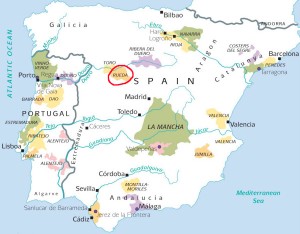In central Spain, Rueda is a white wine buoy bobbing on a vast red sea.
 How vast? Spain produces a billion gallons of wine a year, and Castilla y Leon—Rueda’s home province—is by far the largest autonomous wine region in the country; the biggest region in the entire EU, as a matter of fact. It comprises a fifth of all the land in Spain, and it is solidly red grape country, Tempranillo in particular.
How vast? Spain produces a billion gallons of wine a year, and Castilla y Leon—Rueda’s home province—is by far the largest autonomous wine region in the country; the biggest region in the entire EU, as a matter of fact. It comprises a fifth of all the land in Spain, and it is solidly red grape country, Tempranillo in particular.
And how tiny? Of the hundred thousand winemakers in Spain, only 62 produce Verdejo; a grape considered by many (myself included) to be Spain’s most splendid, age-worthy, non-fortified white wine varietal.
An additional Verdejo plus is that for all intents, it’s grown nowhere else on earth. Although 90% of Rueda is planted to Verdejo, that still only amounts to about eleven thousand acres in total—less than what California plants to Pinot Gris, a grape that Verdejo is said to resemble.
Before being rediscovered by Riojan producer Marqués de Riscal, Verdejo had been nearly forgotten in its native Rueda; that’s partly because it is so prone to oxidation that this became the region’s signature style, often made via a solera system similar to Sherry. Following the phyloxxera plague of the 1800s, Verdejo did not find another Spanish audience for nearly a century.
Beginning in the 1980s, however, a new wave of Riscal-inspired Verdejos have highlighted alternate qualities, focusing on freshness and youth. This, in part, is thanks to the manipulation of modernity. Night harvesting, cool fermentation and the use of an inert gas blanket minimized exposure to air during aging and maintained the crisp, tropical intensity that the grape displays when going through birthing pains.
“I Do Not Know if I Live in Spain to Make Wine or Make Wine to Live in Spain”
Among the handful of Verdejo producers is Didier Belondrade from Montauban, France, who, in 1992, went full Thoreau and left his executive position at Air France to make wine in Spain. He was especially enamored of the indigenous grape Verdejo, convinced that he could make a barrel-fermented, lees aged version patterned after the great Chardonnays of Burgundy.
The style was intended to blend some of the richness inherent in lightly oxidized, wood-aged wine with the keen, aromatic expression of young Verdejo. Key to such an endeavor, of course, is an obsessive attention to detail in all phases of viniculture, from vine to stemware. Rueda is rough country; the climate is harsh, far removed from any meliorating maritime effect, and the soils are poor, composed primarily of iron-heavy limestone. Cereal grain barely eke out a living here, but as it happens, such terrain is ideal for Verdejo, especially when the vineyards are planted in the proximity of the Duero River.
These were the terroirs that excited Belondrade:
“My story began over a glass of Verdejo on a hot day in sun-drenched Andalusia; it occurred to me that I didn’t think the grape was living up to its true potential. With the climate here, Verdejo can be in Rueda what Chardonnay is in Burgundy. But for the techniques of some short-sighted people, we could have been the Great Spanish White Zone.”
That’s the sort of blunt honesty one expects from Belondrade, of course, and it hardly tempers his passion for his adopted country: “Spain,” he maintains, “not only stole my heart, it stirred something deep in my soul.”
He just had to bring a little Burgundian bump to Nava del Rey, creating a wine that incorporates the best of the aged, pre-phylloxera Verdejos of the past with the fresh, acidic Riscal Verdejos.
To achieve this, Belondrade hand-harvests Verdejo from nineteen individual plots, each with unique terroirs, and containing vines of an average age of thirty years. He ages the wine on its lees in 300-liter French oak foudres; the wine is bottled and stored for a further 6 months prior to release.
It was this wine not upon release, however, but several years down the road that intrigued me.
2011 Belondrade y Lurton Verdejo Rueda ($40) is the most sophisticated incarnation of Verdejo I have ever encountered; remarkably textured and complex. It is clearly not a Burgundian Premier Cru, but only because the profile is so distinctly non-Chardonnay: The breeding is every bit as heady.
 The wine opens with lovely perfumes drenched in honey, walnuts, creamy white flowers and apple peel; the acids are in beautiful balance and the slight butterscotch of oak and oxidation is a counterpoint that is suspended within that balance.
The wine opens with lovely perfumes drenched in honey, walnuts, creamy white flowers and apple peel; the acids are in beautiful balance and the slight butterscotch of oak and oxidation is a counterpoint that is suspended within that balance.
To me, the sign of wine at an ideal stage of development is one that manages to flirt with the unique flavors of maturity without any one of them dominating; here, exotic wood notes blend with toasted almond and a touch of anise, but the fruit—predominantly fresh apple—remains keenly alive and of 2017, encompasses the rest.
In short, this is wine of monumental grandeur, and at $40, about a third of what you’d pay for a quality-comparable white from the Côte de Beaune. Some voluminous value in Verdejo Viejo—¿verdad?










I have noticed you don’t monetize your page, don’t waste your traffic, you
can earn extra bucks every month because you’ve got high quality
content. If you want to know how to make extra $$$,
search for: Boorfe’s tips best adsense alternative